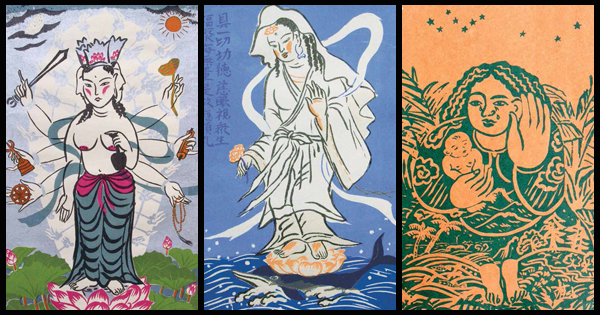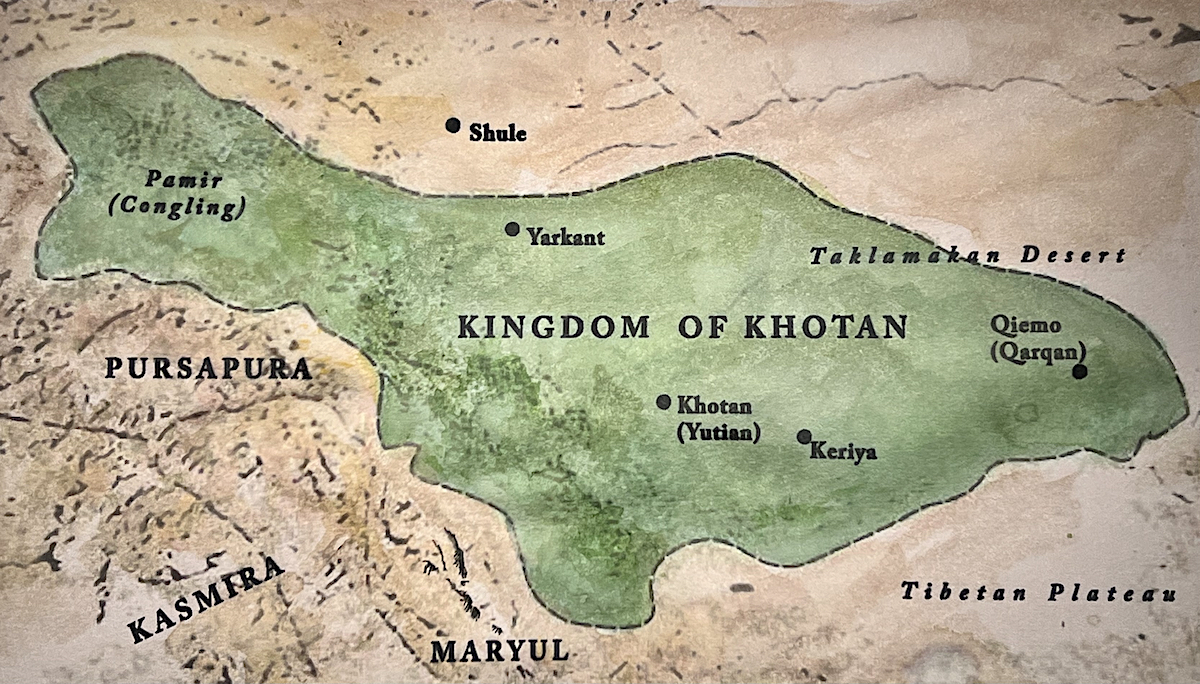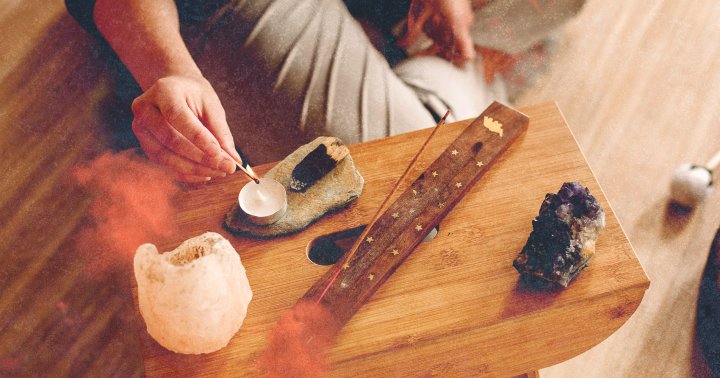How to Be a Bodhisattva
It may seem like an unattainable ideal, but you can start right now as a bodhisattva-in-training. All you need is the aspiration to put others first. The post How to Be a Bodhisattva appeared first on Lions Roar.

It may seem like an unattainable ideal, but you can start right now as a bodhisattva-in-training. All you need is the aspiration to put others first and some inspiration from helpful guides like the Buddhist teachers found here.

“Hands of Compassion” by Mayumi Oda.
Everyone Is Your Guest
Chögyam Trungpa Rinpoche on your life as a future bodhisattva
Many Mahayana scriptures speak of inviting all sentient beings as our guests. When we invite a guest, we have a sense of the importance of that relationship. Guests are usually fed specially cooked food and receive extra hospitality. The life of a bodhisattva is relating with all sentient beings as guests. The bodhisattva invites everyone as a guest, constantly offering a feast.
Inviting all sentient beings as our guests is the starting point of applying compassion in the Mahayana. By viewing sentient beings as guests, the bodhisattva has a constant sense of the impermanence of the relationship, because eventually all guests leave. So we view the time with our guests as precious. There is a sense of the preciousness and the impermanence of the relationship. Our guest may be our husband, our wife, or our child—everybody is the guest of everybody, constantly. On a day to day level, all relationships for a bodhisattva are based on relating with guests.
Just as fish cannot live without water, compassion cannot develop without egolessness.
Compassion is a combination of maitri, or loving-kindness, and generosity. It is a journey outward, a journey of communication. On one level, compassion is feeling friendly toward ourselves. On another level it is experiencing a sense of richness, that we can expand the warmth we feel toward ourselves to other sentient beings.
It is said in the scriptures that just as fish cannot live without water, compassion cannot develop without egolessness and without the experience of emptiness, or shunyata. It may seem that this view of compassion is somewhat abstract, but in fact it is the heart of the practice of meditation in action.
The presence of compassion is experienced as a sudden glimpse, a sense of clarity and warmth simultaneously. According to the scriptures, that glimpse, if you analyze it, takes one-sixtieth of a second. It is so fast and so sharp. The sharpness is the intelligence of the compassion. Compassion also means being open and communicative. It contains warmth.
So, first there is maitri, trusting in the heart.
Second, there is a gap in which you experience the openness of tathagatagarbha, or buddhanature.
Third, there is a sense of communication—having already woken up at that level, there is a sense of freedom to expand and to relate with your actions, whatever you are doing. That seems to be how to develop compassion.
6 Baby Steps to Kindness
The path of compassion, says Judy Lief, starts with stepping out of your usual storyline. Here are five ways to do it.
It is amazing how often we think we are out in the world interacting with and helping others, when actually we are simply acting out our preconceived internal storyline. Our vision is clouded and we can only take in what feeds into our plot line.
One way to soften this pattern is by exploring some basic steps that can lead us in the direction of kindness. Instead of trying to will ourselves to be kind—presto!—we can create an atmosphere congenial to the development of loving-kindness.
Here are five small steps to kindness you can practice. You can explore these steps singularly or in combination. The idea is that if you create the right atmosphere, compassion naturally arises. It is already present, just waiting for your invitation.
Settle DownThere has to be a here to be a there, and a connection between the two. So the first step is to slow down and let your mind settle enough that you are able to drop from the heights of conceptuality back into your body, a simple form in space. Can you really feel present, in your body as it is, right where you are?
Be in the MomentNow that you are more solidly somewhere, you can let yourself be more clearly sometime. When your thoughts drift from the past or the future, from memories and regrets to plans and dreams, you can gently bring yourself back to the present moment.
Drop Escape RoutesStay put in this particular place and time, just the way it is.
Pay Attention to SpaceNotice the quality of space within you and around you. Pay attention to the boundaries of your physical body and the space in front, behind, and on each side of you. Also pay attention to the mental–emotional space that accommodates the comings and goings of sensations, thoughts, moods, and emotional upheavals. Whatever arises on an outer or inner level, notice the space in which both you and your perception rest.
Share the SpaceExplore what it is like to share this space with whoever is there with you. Notice the power of accommodation, acceptance, and nonjudging. When you sense the arising of territoriality and fear, accommodate that too in greater spaciousness.
AlchemyWhat ordinary people see as lead, alchemists see as gold in disguise. Like alchemists, we can learn to uncover the gold hidden within our human condition—no matter how conflicted and unpromising we humans often seem to be. Our dramas and fascinations, our obsessions, our loves gained and lost may captivate us, but they are fundamentally ephemeral. However, anything that awakens and touches our hearts even a little bit can open us to the possibility of something more. Within the fluctuating passions of the human realm, we can discover the unwavering force of selfless compassion and loving-kindness.

“Kanzeon & Dolphin” by Mayumi Oda.
You Deserve Compassion Too
Compassion makes no distinction between self and other, says Christina Feldman. Care for your own suffering in the same way you care for others’.
Some people, carrying long histories of a lack of self-worth or denial, find it difficult to extend compassion toward themselves. Aware of the vast suffering in the world, they may feel it is self-indulgent to care for their own aching body, broken heart, or confused mind. Yet this too is suffering, and genuine compassion makes no distinction between self and other.
The path of compassion is cultivated one step and one moment at a time.
The Buddha once said that you could search the whole world and not find anyone more deserving of your love and compassion than yourself. Yet too many people find themselves directing levels of harshness, demand, and judgment inward that they would never dream of directing toward another person, knowing the harm that would be incurred. They are willing to do to themselves what they would not do to others.
The path of compassion is altruistic but not idealistic. Walking this path we are not asked to lay down our life, find a solution for all of the struggles in this world, or immediately rescue all beings. The path of compassion is cultivated one step and one moment at a time. Each of those steps lessens mountains of sorrow in the world.
The Buddha’s Love
Thich Nhat Hanh describes how love for one person becomes love for all.
Question: More than anything else, we want to love and be loved. Why do we find it so difficult to love?
Thich Nhat Hanh: Love is the capacity to take care, to protect, to nourish. If you are not capable of generating that kind of energy toward yourself, it is very difficult to take care of another person. In the Buddhist teaching, it’s clear that to love oneself is the foundation of the love of other people. Love is a practice. Love is truly a practice.
Why don’t we love ourselves?
We may have a habit within ourselves of looking for happiness elsewhere than in the here and the now. We may lack the capacity to realize that happiness is possible in the here and now, that we already have enough conditions to be happy right now. To go home to the present moment, to take care of oneself, to get in touch with the wonders of life that are really available—that is already love. Love is to be kind to yourself, to be compassionate to yourself, to generate images of joy, and to look at everyone with eyes of equanimity and nondiscrimination.
When people love each other, the distinction, the limits, the frontier between them begins to dissolve, and they become one with the person they love.
As you progress on the path of insight into non-self, the happiness brought to you by love will increase. When people love each other, the distinction, the limits, the frontier between them begins to dissolve, and they become one with the person they love. There’s no longer any jealousy or anger, because if they are angry at the other person, they are angry at themselves. That is why non-self is not a theory, a doctrine, or an ideology, but a realization that can bring about a lot of happiness.
You have written about a woman you loved deeply a long time ago. At this point in your life, do you regret not being with her?
That love has never been lost. It has continued to grow. To love someone, if it is true love, is a very wonderful opportunity for you to love everyone. In the insight of non-self, you see that the object of your love is always there and the love continues to grow. Nothing is lost and you don’t regret anything, because if you have true love in you, then you and your true love are going in the same direction, and each day you are able to embrace, more and more.
So to love one person is a great opportunity for you to love many more. That nourishes you, that nourishes the other person, and finally your love will have no limit. That is the Buddha’s love.

“I Will Be With You” by Mayumi Oda.
Unbearable Compassion
For our compassion to be effective, says Ogyen Trinley Dorje, the 17th Karmapa, it must be as unbearable as the world’s suffering is.
Our compassion must have a broad focus, including not only ourselves and those close to us but all sentient beings. All beings want to be happy and free of suffering, yet most sentient beings experience only suffering and cannot obtain happiness. Just as we have a desire to clear away the suffering in our own experience and to enjoy happiness, we come to see through meditating on compassion that all other beings have this desire as well.
When we practice, we must bring our meditation on compassion to the deepest level possible. We must reflect on the intense suffering of sentient beings in all six realms of samsara. Reflecting on our connection to these beings, we must engender a compassion that cannot bear their suffering any longer.
To make our compassion strong, we need the path.
This great, unbearable compassion is extremely important. Without it, we might feel a compassionate sensation in our minds from time to time, but this will not bring forth the full power of compassion. But when we witness with unbearable compassion the suffering of sentient beings, we immediately seek out ways to free them from that suffering. We are unfazed by complications and doubts; our actions for the benefit of others are effortless and free from doubt.
To make our compassion strong, we need the path. We already have compassion, wisdom, and many other positive qualities, yet our mental afflictions are stronger than these most of the time. It is as if the afflictions have locked all of our positive qualities away in a box.
One day, when we open that box and all of our good qualities spring forth, we will not have to go looking for our compassion. We will discover that compassion is present in our minds spontaneously, and a wealth of excellent qualities will become available to us.
Toward a Culture of Love
Love is the ultimate transgression, bell hooks argues. Its transformative power can shatter the status quo.
To work for peace and justice we begin with the individual practice of love, because it is there that we can experience firsthand love’s transformative power. Attending to the damaging impact of abuse in many of our childhoods helps us cultivate the mind of love. Abuse is always about lovelessness, and if we grow into our adult years without knowing how to love, how then can we create social movements that will end domination, exploitation, and oppression?
To begin the practice of love we must slow down and be still enough to bear witness in the present moment. If we accept that love is a combination of care, commitment, knowledge, responsibility, respect, and trust, we can then be guided by this understanding. We can use these skillful means as a map in our daily life to determine right action.
To be transformed by the practice of love is to be born again, to experience spiritual renewal.
When we cultivate the mind of love, we are, as Sharon Salzberg says, “cultivating the good,” and that means “recovering the incandescent power of love that is present as a potential in all of us” and using “the tools of spiritual practice to sustain our real, moment-to-moment experience of that vision.”
To be transformed by the practice of love is to be born again, to experience spiritual renewal. What I witness daily is the longing for that renewal and the fear that our lives will be changed utterly if we choose love. That fear paralyzes. It leaves us stuck in the place of suffering.
When we commit to love in our daily life, habits are shattered. Because we no longer are playing by the safe rules of the status quo, love moves us to a new ground of being. We are necessarily working to end domination. This movement is what most people fear. If we are to galvanize the collective longing for spiritual well-being that is found in the practice of love, we must be more willing to identify the forms that longing will take in daily life.
Folks need to know the ways we change and are changed when we love. It is only by bearing concrete witness to love’s transformative power in our daily lives that we can assure those who are fearful that commitment to love will be redemptive, a way to experience salvation.

 Troov
Troov 































